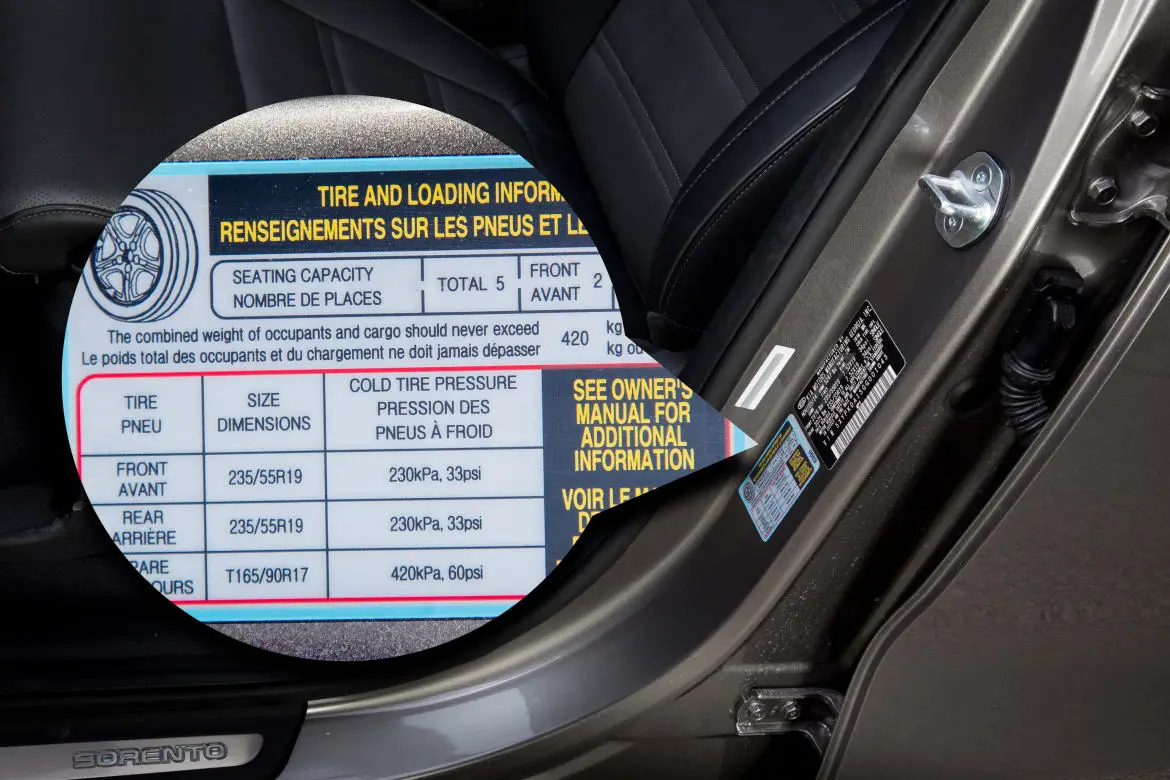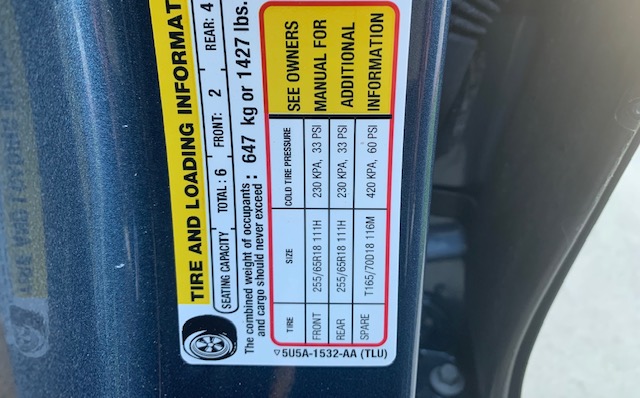The recommended tire pressure for your car is usually found in the owner’s manual or on a sticker inside the driver’s door. Most cars require between 30-35 PSI.
Maintaining the correct tire pressure is crucial for safety and performance. Properly inflated tires ensure optimal handling, fuel efficiency, and tire longevity. Under-inflated tires can lead to poor handling, reduced fuel economy, and increased tire wear. Over-inflated tires can cause a harsh ride and uneven tire wear.
Regularly check your tire pressure using a reliable gauge. Ensure to measure the pressure when the tires are cold. Adjust the pressure as needed to match the manufacturer’s recommendations. Keeping your tires at the correct pressure can save money and improve driving safety.

Essential Tire Pressure Facts
Maintaining the right tire pressure is crucial for your car’s safety and performance. Correct tire pressure ensures a smooth ride, better fuel efficiency, and longer tire life. Below are some essential facts about tire pressure that every car owner should know.
Importance Of Correct Tire Pressure
Having the correct tire pressure helps in many ways. Properly inflated tires provide better traction and handling. This makes your car safer to drive. Correct tire pressure also improves fuel efficiency. Your car uses less gas when tires are properly inflated. Additionally, it ensures even tire wear, extending the life of your tires.
- Better traction and handling
- Improved fuel efficiency
- Extended tire life
Risks Of Improper Inflation
Driving with incorrect tire pressure can be dangerous. Under-inflated tires can overheat and fail. Over-inflated tires can lead to blowouts. Both situations can cause accidents. Improper tire pressure also affects your car’s performance. It can lead to poor fuel economy and uneven tire wear.
| Type | Issue | Result |
|---|---|---|
| Under-inflated | Overheating | Tire failure |
| Over-inflated | Blowouts | Accidents |
| Incorrect pressure | Poor fuel economy | Uneven tire wear |
To avoid these risks, check your tire pressure regularly. Use a reliable gauge. Follow the manufacturer’s recommendations for your car.

Determining Your Car’s Perfect Tire Pressure
Understanding your car’s perfect tire pressure is crucial for safety. Proper tire pressure improves fuel efficiency and ensures a smooth ride. To determine your car’s perfect tire pressure, follow these steps.
Vehicle Manufacturer Recommendations
The vehicle manufacturer provides specific tire pressure recommendations. These recommendations are found in the owner’s manual. The manual contains detailed information about the correct tire pressure for your car.
Each vehicle has unique tire pressure needs. For different driving conditions, refer to the manual for adjustments. Always follow the manufacturer’s guidelines for the best performance.
Below is a sample table illustrating different tire pressure recommendations:
| Vehicle Type | Front Tires (psi) | Rear Tires (psi) |
|---|---|---|
| Sedan | 32 | 30 |
| SUV | 35 | 33 |
| Truck | 40 | 38 |
Reading The Tire Pressure Label
Another way to find the recommended tire pressure is by reading the tire pressure label. The label is usually located inside the driver’s door frame. It contains essential tire information.
Follow these steps to read the tire pressure label:
- Open the driver’s side door.
- Look for a sticker on the door frame.
- Find the recommended tire pressure in psi.
It’s important to check the tire pressure regularly. Use a reliable tire pressure gauge for accurate readings. Keeping your tires at the recommended pressure ensures your car runs safely and efficiently.
Influences On Tire Pressure Levels
Many factors can affect the recommended tire pressure for your car. Understanding these influences helps maintain optimal performance and safety. Let’s explore the key factors.
Temperature Changes
Temperature impacts tire pressure significantly. Cold weather causes the air inside tires to contract. This results in lower tire pressure. Conversely, warm weather makes the air expand, raising tire pressure.
Below is a simple table to illustrate temperature effects:
| Temperature | Tire Pressure Change |
|---|---|
| Cold | Decrease |
| Warm | Increase |
Check tire pressure regularly, especially during seasonal changes. Aim to keep it within the manufacturer’s recommended range.
Load Dynamics
The load your car carries also affects tire pressure. Heavier loads increase the pressure on the tires. This can lead to over-inflation if not monitored.
Here are some tips to manage tire pressure based on load:
- Check tire pressure before adding heavy loads.
- Adjust pressure according to the load recommendations in your car’s manual.
- Recheck and adjust after unloading to return to normal levels.
Maintaining the correct tire pressure ensures better fuel efficiency, tire longevity, and driving safety.
Maintaining Optimal Tire Pressure
Maintaining optimal tire pressure is essential for safe driving. Proper tire pressure improves fuel efficiency and ensures a comfortable ride. Regularly checking tire pressure helps avoid accidents and extends tire life.
Regular Check-up Routine
Create a routine to check tire pressure monthly. Always check tire pressure before long trips. Use the tire pressure gauge when tires are cold. Cold tires give a more accurate reading.
Follow the manufacturer’s guidelines for the correct tire pressure. These guidelines are found in the car manual or on the driver’s side door jamb. Under-inflated tires cause poor fuel economy and increased wear. Over-inflated tires lead to a harsh ride and reduced traction.
Tools For Measuring Tire Pressure
Several tools are available for measuring tire pressure. A digital tire pressure gauge provides an accurate reading. It’s easy to use and has a clear display. A pencil-style tire pressure gauge is another option. It’s compact and fits in a glove box.
A tire pressure monitoring system (TPMS) is a high-tech solution. It alerts drivers when tire pressure is low. Many modern cars come with TPMS already installed. For older cars, a TPMS can be added.
| Tool | Advantages | Disadvantages |
|---|---|---|
| Digital Tire Pressure Gauge | Accurate, clear display | Requires batteries |
| Pencil-Style Tire Pressure Gauge | Compact, no batteries needed | Less accurate |
| Tire Pressure Monitoring System (TPMS) | Real-time alerts | Expensive, complex installation |
Impact Of Tire Pressure On Safety And Performance
Proper tire pressure is crucial for your car’s safety and performance. It affects handling, fuel efficiency, and tire lifespan. Maintaining the recommended tire pressure ensures a smooth and safe ride.
Improved Handling And Stability
Correct tire pressure improves your car’s handling and stability. It helps the tires grip the road better, especially during turns. This reduces the risk of skidding and improves braking performance.
Underinflated tires can make your car feel sluggish. Overinflated tires can make your ride harsh and uncomfortable. Both conditions can lead to uneven tire wear and potential blowouts.
Fuel Efficiency Benefits
Maintaining proper tire pressure saves fuel. Underinflated tires create more rolling resistance. This means your car engine works harder, using more fuel.
Properly inflated tires reduce rolling resistance. This makes your car more fuel-efficient, saving you money at the pump.
Here is a simple comparison of the effects of tire pressure on fuel efficiency:
| Tire Pressure | Fuel Efficiency |
|---|---|
| Underinflated | Lower Efficiency |
| Properly Inflated | Optimal Efficiency |
| Overinflated | Variable Efficiency |
Keeping your tires at the recommended pressure is simple. It ensures safety, improves performance, and saves fuel. Check your tire pressure regularly for a safer, smoother ride.

Frequently Asked Questions
Is 40 Psi Good Tire Pressure For Car?
40 PSI might be too high for most car tires. Check your vehicle’s manual for the recommended pressure.
How Do I Tell What Psi My Tires Need?
Check the tire’s sidewall or your vehicle’s owner’s manual. Look for the recommended PSI information there.
What Tire Pressure Should I Put In My Car?
Check your car’s owner’s manual or the sticker inside the driver’s door. Typically, tire pressure ranges from 30-35 PSI.
Is 35 Psi Too High?
35 PSI can be too high for some vehicles. Always check your car’s manual for the recommended tire pressure.
What Is The Perfect Tire Pressure?
The perfect tire pressure is usually between 30-35 PSI. Check your vehicle’s manual for exact recommendations.
Conclusion
Ensuring your car’s tires are properly inflated is crucial for safety and performance. Regularly check your tire pressure to avoid issues. Proper tire maintenance improves fuel efficiency and extends tire life. Always refer to your vehicle’s manual for the recommended tire pressure.
Stay safe on the road with well-maintained tires.





















